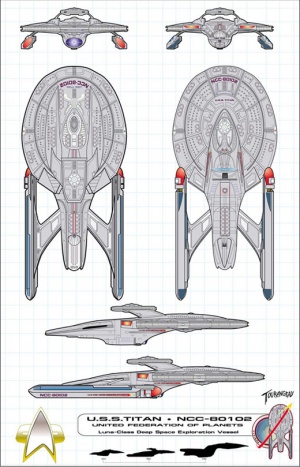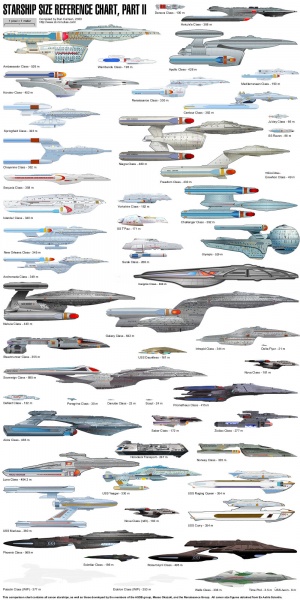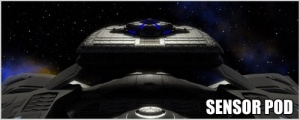
The Luna-class was designed by Dr. Xin Ra-Havreii, of Utopia Planitia Fleet Yards on Mars, and initially conceived for scientific exploration of the Gamma Quadrant following the discovery of the Bajoran Wormhole. The project was sidelined by the impending threat from the Dominion, then restarted following the end of the Dominion War.
The Luna-class ships were the top of the line in Starfleet's scientific and exploratory pursuits on behalf of the United Federation of Planets. Each had an average crew of the 350 individuals and was approximately 450 meters long. Their shuttlebays were reminiscent of the old Constitution-class shuttlebays, having a more rounded opening door. They also featured a longer "runway" for shuttles as they entered and exited the ship.
All Luna-class starships were named after moons. The first production lot was named after moons in the Sol system.

Personnel Compliment
Crew Compliment:
- 500 crew (75 Officers, 425 Enlisted Crew)
- Evacuation Limit: 8,000
Dimensions
- Overall Length 454.3 m
- Overall Beam (Width) 203.9 m
- Overall Draft (Height) 80.7 m
Saucer Section:
- Saucer Length 246.3 m
- Saucer Beam 203.9 m
- Saucer Draft 37.6 m
Engineering Hull:
- Engineering Length 254.5 m
- Engineering Beam 72.5 m
- Engineering Draft 52.5 m
Sensor Module:
- Sensor Module Length 88.2 m
- Sensor Module Beam 54.8
- Sensor Module Draft 18.2 m
Shuttlebay Entrance:
- Shuttlebay Beam 23.9 m
- Shuttlebay Draft 10.5 m
- Mass: 1,250,000 metric tons
- Decks 16 Total (13 in Main Hull, 3 in Sensor Pod)
Powerplant
- One M/A Reactor feeding 2 Nacelles
- 2 Impulse Engines
Performance
- Cruising Speed Warp 7.5
- Max Speed Warp 9.99 for 12 Hours
- 12 High-Burst Combat Maneuvering Thrusters
Armament
- 5 x Type XII Phaser Arrays
- 3 x Torpedo Launchers + 450 Torpedoes (2 fore / 1 aft) (150 Quantum & 300 Photon)
Defenses
- Auto-Modulated Shields
- 4 Point-Defense Batteries
- Multi-Directional Object Collision-Interference Grid
- Ablative Armor
Transport Equipment
- 10 x Mixed Personnel Shuttles
- 4 x Work Bees
Sensor Pod

The sensor pod located on top of the USS Charon’s saucer section contains several complicated and advanced components. Most notably the sensor pod is equipped with extremely powerful scanners that enable it to create accurate representations of stellar bodies. It feeds these representations into the Stellar Cartography lab where a three dimensional holographic representation of the surrounding space can be displayed.
Aside from its Stellar Cartography use the sensor pod is able to do chemical and organic analysis of stellar phenomenon from a large distance.
Due to the sophisticated machinery in the sensor pod only the Chief Science Officer is permitted to realign the sensor settings.
